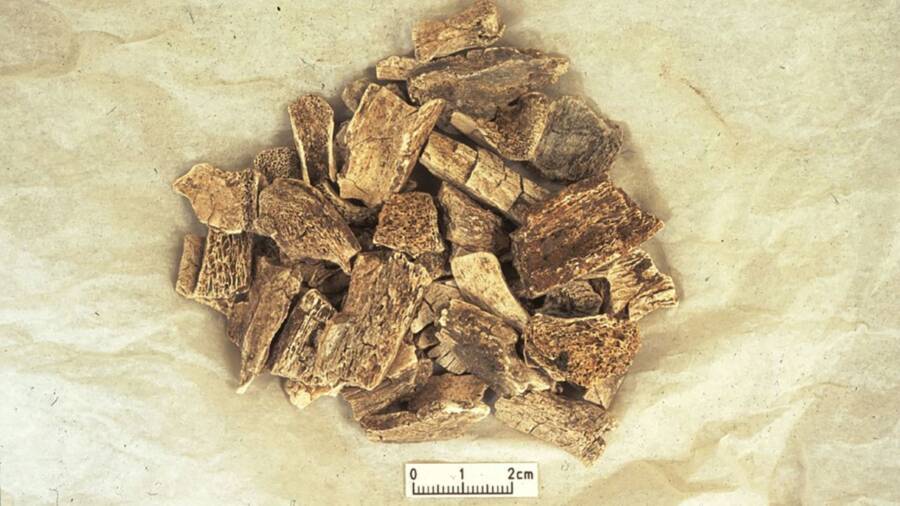By analyzing bones found in England, researchers confirmed that Vikings transported animals like horses and dogs from Scandinavia to Britain.

Julian Richards/University of York The excavation site where researchers found evidence of animals brought from Scandinavia.
Throughout history, pets have held a special place in the hearts and homes of human beings. Now, animal remains excavated from a Viking burial mound in England have revealed that Vikings felt the same way about their own animals, even transporting them hundreds of miles on cramped ships just to be close to them — and eventually, to die with them.
From as early as the 9th century, the Vikings, a group of warrior people from Scandinavia, made the journey across the North Sea to conduct raids on England. A formidable seafaring people, the Vikings were very successful at capturing British villages along the coasts using well-designed vessels.
Based on evidence found in a historical record called the Anglo-Saxon Chronicle, researchers long believed that many of these raids were conducted with the help of horses the Vikings seized from locals. However, a new study published in PLOS ONE points to a different reality.
In the study, researchers examined a Viking burial mound in Derbyshire, England. Originally excavated in the 1990s, the mound is one of 59 that comprise a Viking cremation cemetery known as “Heath Wood.”
This particular mound contained the cremated remains of two adult humans and one child, as well as a horse, a dog, and possibly a pig.

Julian Richards/University of YorkCremated animal and human bones found at the Heath Wood burial mound.
Using isotopic analysis methods, researchers tested the bone fragments for strontium, a natural material found in soil, rocks, and water. Strontium accumulates in animals’ bones over time based on what they eat, and so can offer clues as to where animals primarily lived throughout their lifetime.
By comparing the strontium levels in the bone fragments to ratios in other animal bones, the researchers were able to pinpoint the Baltic Shield, an area that includes parts of modern-day Sweden and Norway, as the region the bones had come from. That means that the animals spent most of their lifetimes consuming water and food in Scandinavia — not Britain.
This new finding expands upon previous notions about the Vikings’ use of animals in Britain, explains lead study author Tessi Löffelmann, a doctoral researcher at Durham University and Vrije Universiteit Brussels.
“Basically, it deepens our understanding of the Viking Great Army when it first arrived on British shores in East Anglia,” Löffelmann told CNN. “Our main primary source of the time, the Anglo-Saxon Chronicle, reports that the Army seized horses in Britain from the local population, but our isotopic evidence shows that this was not the only story — they also brought animals with them from their homelands.”
According to CNN, the animals most likely belonged to the humans whose bones were found in the same burial mound. It is probable that the animals traveled with their owners from Scandinavia, and were then sacrificed after their owners died to be buried with them.
The study reveals just how much Viking explorers valued their animals, particularly horses and canines.
“Animals had an important role to play in [Viking] society,” Löffelmann said in an email to CNN. As pagan people with a strong oral tradition, the Vikings told stories of gods turning themselves into animals, horses ferrying warriors into the afterlife, and more. These beliefs were integral to the Vikings’ religious tradition until they eventually adopted Christianity.
The fact that Vikings brought their animals from their homeland also changes the way historians view their expeditions to Britain. Even in a deep-cargo vessel, storing animals aboard would have been “wet, cold, and uncomfortable for all parties involved,” Löffelmann said.
It is no surprise then that pre-Christian Vikings would bear the uncomfortable, unsanitary, and often dangerous journeys to Britain with their favorite animals at their side.
“It could have only been selected animals that made that journey,” Löffelmann told ScienceNews. “They were important to what the person was. They went through life together, and now they’re going through death.”
After reading about the love Vikings had for their animals, discover some of the most bizarre pets you can legally own. Or, read about 32 Viking facts that demonstrate just how misunderstood their culture was.





